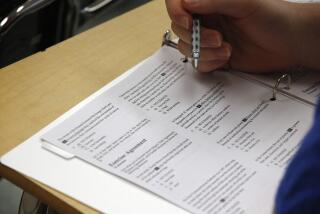ACT is to SAT as . . .
- Share via
Thomas Chun took the SAT college entrance exam twice, scoring well within qualifying range for prestigious research universities, if hundreds of points short of the top mark.
Still, Chun believed his score, 2090 out of a possible 2400, might not stand up against those of other whiz kids at Whitney High, his selective magnet school in Cerritos. So he took the other admissions test, the ACT, and scored a perfect 36.
“I was never a big fan of the SAT,” said Chun, 17, of Cerritos, who since sixth grade has dreamed of going to Yale. “The ACT tests you on what you learned in high school rather than what you learned in test prep academy.”
The ACT was once the overlooked stepsister to the SAT. It was popular in the Midwest and the South but less established on the East and West coasts. Now, however, the ACT is growing faster than its rival, not only nationally but also in SAT strongholds such as California, where 50% more students in the class of 2008 took the ACT than their 2004 counterparts. Nationwide, the ACT was taken by 1.4 million students in the 2008 class, compared with 1.5 million who took the SAT, according to the test companies.
It is not clear why the ACT, which has competed against the older SAT since 1959, is surging now. There is no evidence that one test is easier or harder than the other, and most colleges consider them equally valid.
The SAT has been battered by accusations of elitism and cultural bias, and recent revisions to the exam -- prompted by criticism from the University of California -- have stirred uncertainty that sent some students scrambling for an alternative, several experts said.
In addition, ACT precursor tests are being marketed to younger and younger students, and the test is cheaper than the SAT. In California, many students appear to use the ACT as a backup, to game the increasingly fierce college admissions competition. At the University of California, which accepts either test, one-third of fall freshman submitted ACT scores, up from 28% the year before. California State University schools accept the SAT or the ACT from students who are required to submit test scores.
“But we are still an ‘SAT state,’ with 97.0% of all test takers taking the SAT (or a combination of SAT/ACT),” Susan A. Wilbur, UC director of undergraduate admissions, wrote in an e-mail.
“Our national obsession with high-stakes testing induces students to hedge their bets by taking both tests, and multiple times,” said Barmak Nassirian, associate executive director of the American Assn. of Collegiate Registrars and Admissions Officers.
“Instead of competing with each other in a zero-sum manner, both test companies benefit from admission anxieties,” he said.
Despite its growth, the ACT still lags behind its rival in California, with 72,356 test-takers for the 2008 class compared with the SAT’s 205,145. For some students, the ACT seems a bit, well, lame.
“The ACT, it’s an out-there test for me,” said Whitney High senior Milly Shah. “And 36 seems like a weird number.”
At John Marshall High School in Silver Lake, where it seems virtually every student wants to go to UCLA, the ACT is the underdog, some students said.
“It’s like in sports. . . . The SAT is football and the ACT is water polo,” said Tina Bui, 17, of Atwater Village.
But Campbell Hall, a private school in North Hollywood, recommends that students take both the SAT and the ACT in their junior year to set a “benchmark,” said college counselor John M. Corona. Most students take a test preparation class and at least one of the exams again senior year, he said.
Senior Jack Acland, 17, said he was leaning toward the SAT but followed the recommendation to take both tests.
“I thought I would do better on the SAT, but I did slightly better on the ACT,” the Sherman Oaks resident said.
Bui also plans to take the ACT and the SAT -- two times each. “Teachers say take it, take it, take it as many times as you can,” she said.
Chun took eight standardized tests in his junior year: two SATs, three AP tests, two SAT subject tests (all owned by College Board) and the ACT. He also took the state standards tests.
For college-bound students, the relative merits of the tests are topics of minute dissection. The SAT marks off a only quarter-point for wrong answers, so it’s better for guessers. The ACT is easier for students who memorize well, the SAT for those with analytic skills. The ACT is hard to finish on time . . . no, that’s the SAT. The ACT is for girls, the SAT is for boys. Test prep classes work for the SAT, not the ACT. Or is it the other way around?
Testing officials say the theories about which test is better for specific types of students are all myths. Some counselors recommend the SAT for underachievers who like strategy games and the ACT for those who do well in class.
“But students should not expect a miracle; the vast majority score very closely on both tests,” said Jake Neuberg, co-founder of Santa Monica-based Revolution Prep, a test preparation company.
“I’ve heard that at the top schools -- Ivies and whatnot -- many applicants submit both a SAT and an ACT . . . does doing so make you a more favorable candidate than a person who submitted just an ACT or vice versa?” a student wrote last week on the popular Web discussion forum College Confidential. Most colleges would answer no.
The SAT, which used to stand for the Scholastic Aptitude Test, has sections on reading, math and writing, takes three hours and 45 minutes and costs $47. The ACT, which used to stand for American College Testing, has reading, math, science, English and optional writing sections, lasts two hours and 55 minutes and costs $31; the optional writing section adds $15 to the cost and a half-hour to the exam time.
The two testing giants have agreed on a conversion chart that shows how a score on the ACT’s 36-point scale might correspond to the SAT’s 2400-point matrix. And they agree on something else: The only way to improve a score is to take rigorous courses and study hard.
And don’t forget the No. 2 pencil.
“We don’t see this as a horse race,” said Laurence Bunin, a senior vice president of the College Board, the New York-based nonprofit that owns the SAT. “The SAT is the leading test already, with consistent growth each year.”
Overtaking the SAT “is not a goal of ours,” said ACT spokesman Scott Gomer. “Our goal is to help out as many students as we can go to college or into work force training.”
The increased competition comes as some colleges, including, recently, Smith College in Massachusetts, have stopped requiring test scores. But many states are promoting high-stakes tests by paying for high school students to take them.
Colorado, Illinois, Michigan, and more recently, Kentucky and Wyoming have adopted the ACT as a standardized high school assessment test. Wyoming students have the option of taking a career assessment exam instead of the ACT.
Earlier this year, the U.S. Department of Education certified a modified SAT as Maine’s high school assessment test under the federal No Child Left Behind requirement. Several other states, including New Mexico and Washington, also have expressed interest in adopting the SAT as a standardized exam, said Dan Hupp, Maine’s director of educational assessment. College Board officials would not confirm the statement, saying they do not discuss negotiations. A spokeswoman for New Mexico said the state’s test bidding process will be open to the ACT and the SAT.
The College Board has also persuaded 22 school districts in California, including Los Angeles Unified, to pay for students to take the PSAT, a practice test for the SAT. L.A. Unified spends about $400,000 for all 10th graders to take the PSAT, a spokeswoman said.
Even students who plunge into the testing frenzy wholeheartedly say they don’t think the entrance exams are the best measure of a student.
“The stress is so great,” said Amanda Davis, 17, a student at Hamilton High, a humanities magnet school in Los Angeles. “You just hope the colleges look at everything combined, not just one test.”
Chun, the son of first-generation Korean immigrants, says it’s worth the pain. “I know students outside the U.S. would kill to take tests like this, to get into a really prestigious college. Or any college.”
--
More to Read
Sign up for Essential California
The most important California stories and recommendations in your inbox every morning.
You may occasionally receive promotional content from the Los Angeles Times.










